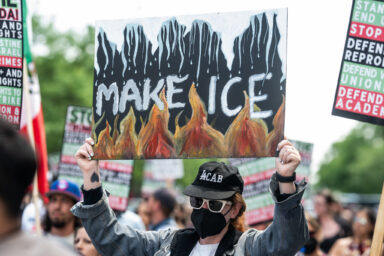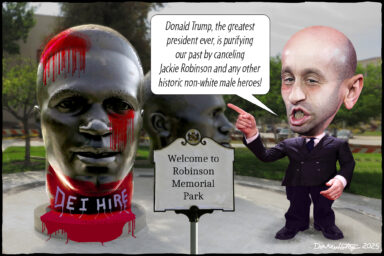President Donald Trump’s attempted quid pro quo isn’t the first by a corrupt Republican president eager to discredit a likely Democratic opponent.
Have you seen Martin’s Scorsese’s latest movie, The Irishman? If not, you should. It is a brilliantly acted, old-fashioned drama that explores a dark vein of American history — the corruption of the country’s biggest union in the 20th Century.
The movie introduces to younger audiences one of the great characters of that dark history, James Hoffa, whose Teamsters union represented the country’s truckers. Hoffa is played by Al Pacino; Robert DeNiro plays Hoffa’s longtime friend, enforcer, and body man, Frank Sheeran.
Hoffa eventually went to prison for attempted bribery and fraud; four years after his release he “disappeared.” That cold case remains one of the nation’s most intriguing unsolved crimes. The movie points to a possible explanation, but my purpose here is not to act as spoiler. Rather, it’s to talk about a presidential quid pro quo from that period, one that had Hoffa at its heart and bears an astounding resemblance to the charges underlying the current impeachment process.
To put the parallel as simply as possible: In 2019 President Donald Trump sought a quid pro quo in the form of a corruption investigation that would smear his main Democratic opponent in the run-up to the 2020 primaries. That opponent was Joe Biden, who has been leading Democratic polls. Trump’s hope was apparently to weaken Biden to the point where he would self-destruct or withdraw, thus facilitating Trump’s reelection against a less popular Democratic candidate. Although the scheme was ultimately exposed by a whistleblower and the House impeachment inquiry that followed, that does not mean it has not already achieved the intended damage. Central to this quid pro quo was the new president of Ukraine and a Ukrainian gas company for which Biden’s son Hunter worked.
In 1971 Richard Nixon sought a quid pro quo in the form of fake information with which to smear his main Democratic opponent in the lead-up to the 1972 primaries. The hope of Nixon’s reelection campaign, led by his corrupt attorney general, John Mitchell, was to embarrass and weaken his opponent, thus assuring Nixon’s reelection over a weaker Democratic field. Nixon’s target was Sen. Ed Muskie of Maine, then leading in all of the Democratic polls. At the center of this quid pro quo was Jimmy Hoffa.
To understand the Nixon quid pro quo one has to go back to the early 1960s. At the time, William Loeb — the owner and editor of the New Hampshire’s only statewide newspaper, the conservative Manchester Union-Leader (today the New Hampshire Union Leader) — desperately needed money to expand his publishing empire. He reached out to Hoffa, who was known to hand out union pension money in the form of loans, many of them illegal, to supplicants who were often mob figures hoping to fund projects such as Las Vegas casinos. Hoffa came through, lending Loeb more than $2 million (about $17 million in today’s dollars) over two years.
Loeb was a prominent Republican, and his newspaper, the largest in Manchester, had long played a central role in presidential politics for the simple reason that the New Hampshire primary was then, as now, the first primary state to vote. The Teamsters loan so obligated Loeb to Hoffa that when the Teamsters boss went to federal prison a few years later, Loeb immediately began scheming for his release. He also demonstrated his fealty by flying a giant banner over the prison wishing Hoffa a happy birthday.
Loeb’s first bright idea was to bribe J. Edgar Hoover, the legendary head of the FBI, into fabricating evidence that Hoffa had been illegally wire-tapped by Robert Kennedy’s Justice Department, thinking such evidence might overturn his conviction and trigger his release. Loeb made his bribe offer over the phone to Hoover’s number two, Cartha (“Deke”) DeLoach, offering $100,000. Loeb told DeLoach that Hoover could either keep the money for himself or, alternatively, that Loeb would direct it to Hoover’s favorite charity. Hoover declined and DeLoach later testified about the call.
When that attempt failed, Loeb’s next stop was the White House. He wrote a letter to Nixon’s campaign chair and attorney general, John Mitchell, claiming that the president was in “political trouble,” and that he, Loeb, was more than willing to help, but “By God, I expect something in return.” The existence of this letter eventually became known because Arthur Egan, Loeb’s top investigative reporter, shared the information with a man named Edward Partin, the government’s main witness in the Hoffa case. What Loeb wanted from the White House — had wanted for years — was Hoffa’s early release from prison. What Mitchell and presumably Nixon himself wanted in return was dirt on Muskie. Muskie was a well-respected centrist Democrat with a clean record, so any dirt would have to be fabricated.
Thus was born the quid pro quo: dirt on Muskie for a pardon for Hoffa. Nixon executed his part of the bargain at the end of 197I, awarding Hoffa a “Christmas clemency” on December 23. Hoffa walked out of Lewisburg prison the same day. Once outside the prison’s walls, Hoffa’s first telephone call was to Loeb. The second half of the quid pro quo would come two months later in the midst of the New Hampshire primary, even though no one other than the principals knew at the time that the two events were connected. It turns out that while the details of Hoffa’s executive clemency were being hammered out in the White House, Nixon’s reelection campaign headquarters were busy working on a fake letter to sabotage Muskie. The notion was that Loeb would hold onto the fabricated letter and then “drop” it at the most propitious moment on the unsuspecting Democratic frontrunner. It was a matter of exquisite timing, much like the 2016 drop of John Podesta’s emails just hours after Trump’s mortifying Access Hollywood tape (“grab them by the pussy”) broke in the news.
Writing a fake letter was all in a day’s work for Nixon’s Committee to Reelect the President, otherwise known as CREEP. The campaign had a whole back-office operation for dirty tricks against Democrats, which was referred to as “ratfucking” by Donald Segretti, the man who set up the operation. Much of the shop’s attention that late winter of 1971 concentrated on a full-throttle offensive against the senator from Maine. It went well beyond the letter at issue here, and included many other fake letters written on stolen copies of Muskie’s campaign letterhead, stolen polling data, and phony campaign flyers. Reflecting on all of it years later, David Broder, who covered Muskie for the Washington Post, would write: “On and on the list went, making it clear that Muskie was the victim of systematic sabotage.”
The letter that CREEP operatives ultimately wrote was published on the front page of the February 24, 1972, Union-Leader, 63 days after Hoffa walked out of prison. Its fictitious author claimed to have overheard Muskie in Florida laughing while people in the senator’s presence made fun of French Canadians. Liberally salted with misspellings, and, according to those who saw it, written in an “almost childlike hand,” the letter soon became infamously known as the “Canuck letter.”
At first blush this hardly sounds like the stuff that might bring down a formidable presidential campaign. But in fact it was genius. Nixon’s operatives understood that Muskie’s state of Maine, as well as New Hampshire, bordered on Canada. The many French Canadians residing within their borders formed a crucial voting block. The substance of the letter did not in any way reflect Muskie’s character or his behavior. Indeed, it was so outrageous as to seem designed to provoke a reaction. To add insult to injury, in the same edition of the Union-Leader in which Loeb ran the CREEP letter, he also published a vicious editorial against Muskie, plus a separate article attacking Muskie’s wife for drinking and swearing. It was a devastating three-pronged frontal assault.
To his undying regret, Muskie took the bait. His campaign hired a truck and drove it right up to the front door of the Union-Leader’s building. In the midst of a snowstorm Muskie stood on the flatbed and delivered an embittered personal attack against Loeb, calling him a “gutless coward.” Attacking Loeb while defending himself and his wife, Muskie became choked up with emotion. Witnesses still debate among themselves whether the senator in fact cried or was simply wiping away the snowflakes that were melting on his face. Broder would write in the Washington Post: “In defending his wife, Muskie broke down three times in as many minutes — uttering a few words and then standing silently in the near blizzard, rubbing at his face, his shoulders heaving, while he attempted to regain his composure sufficiently to speak.”
The Nixon/Mitchell/Segretti dirty trick had succeeded beyond anyone’s wildest dreams. Muskie’s tears became a story that ran on ad nauseam in the media, much like the Hillary Clinton email “scandal” throughout 2016. Muskie never recovered. Yes, he won New Hampshire two weeks later, but hardly by the commanding margin everyone had expected, and he soon withdrew from the primaries altogether. As Muskie told Broder in an interview later, “The first reaction I heard that day was positive, that I had confronted Loeb and told him what I thought. Only later did I hear the reaction that it was a sign of weakness on my part, that it was disturbing people. Eventually, the reaction was devastating.”
Nixon went on to defeat George McGovern in a crushing landslide, notwithstanding the developing scandal that would be known as Watergate.
It is interesting to speculate whether, in releasing Hoffa from prison as his part of the quid pro quo, Nixon had not only sealed Muskie’s fate but, unwittingly, Hoffa’s as well. The Teamsters leader had many enemies who had only grown more powerful while Hoffa was behind bars. Once he was out and trying to regain control of what he regarded as his union, Hoffa became a man with a large and growing target on his back. Much of the last part of The Irishman tells the story of his struggle for control of the union in the years that followed his early release.
Looking back on his contemporaneous reporting, David Broder wrote in the February, 1987, issue of the Washington Monthly that the Muskie story “nags at me as few other stories I have written.” Had he known in 1972 what he would learn just a few years later, Broder said, he might have described Muskie quite differently — not as the victim of “his too-human temperament, but as the victim of a fraud, managed by operatives of a frightened and unscrupulous president.”
So we come full circle, to the Trump impeachment. The strategies of both presidents to defame their leading political opponents were, as noted, eerily similar. Both quid pro quos depended on substantial incentives to get third parties to do their dirty work. In Trump’s case the third party was the president of Ukraine and the incentive was an oft-promised meeting in the Oval Office, not to mention hundreds of millions of dollars worth of vital military assistance in the midst of a hot war with Russia. In Nixon’s case, the third party was a top Republican publisher perfectly positioned to influence an election, and his incentive to cooperate was the much-sought release from prison of his main benefactor.
But there was this crucial difference: Nixon kept his scheme within the four corners of the US. His corruption in the matter of the 1972 presidential election was not only domestic but it was overshadowed by so much other perfidy that it was soon lost to history. Trump’s operatives, on the other hand, went abroad to solicit help from a foreign country over the course of several months.
It may still turn out that Trump was a repeat offender in terms of foreign influence. Roger Stone’s recent conviction for lying about the Russian-hacked Wikileaks dumps of Democratic emails casts fresh doubt on Trump’s professed innocence in the 2016 Russian interference. Stone is not only one of Trump’s oldest friends but for years was the lobbying partner of Paul Manafort, Trump’s now jailed former campaign manager. In light of Stone’s recent testimony, Trump’s written responses to special counsel Robert Mueller regarding the Russian-hacked emails now seem, at best, disingenuous.
Dark Shadows: Iran-Contra, Secret Wars & Covert Operations, Part 1
Foreign interference was a burning issue to the framers of the Constitution. They cherished the independence of their embryonic democracy above all else, and feared meddling by more powerful enemies and even by allies. But that was back in the 18th Century. The question hanging in the balance now is whether foreign interference still matters as much, or at all. While we’re at it, does the Constitution itself still matter to the president and his allies, many of whom claim to be originalists?
Trump has recently called an important part of the Constitution which he routinely flouts — the emoluments clause — “phony.” Because the Democrats have charged Trump with neither treason nor bribery, his impeachment hung on the maddening phrase “high crimes and misdemeanors.” Those opaque words were added to the Constitution only after George Mason of Virginia pointed out that the first two counts of impeachment, “treason and bribery,” left plenty of room for a president to commit many “great and dangerous offenses” that would not qualify as grounds for removal.
Michael J. Klarman, the author of The Framers’ Coup: The Making of the United States Constitution, suggests that the Constitution gave presidents so much latitude largely because of the authors’ high opinion of the leader before them, George Washington. As smart and farsighted as they were, the framers apparently could not envision that American voters — the “educated citizenry” that Thomas Jefferson dreamed of — would elect someone with a long, established record of mendacity and immorality, such as Trump’s. Nor did they fully appreciate the possibility that the Senate as a whole might turn out to be as corrupt as the president that it was trying.
In American Dialogue: The Founders and Us, Joseph J. Ellis writes that one concern of the anti-Federalists was the notion of making the president triable for impeachment by the very senators “with whom he shared various powers.” Packing the courts, both Supreme and otherwise, immediately comes to mind. As skeptical as the anti-Federalists might have been on that point, they could hardly have imagined the surreal situation that now confronts us. On the eve of a Senate impeachment trial, the majority leader proudly preens in front of cameras to proclaim that he, Mitch McConnell (R-KY) — in effect, the foreman of the jury — will be taking his direction from the accused, Donald J. Trump. In other words, well before the opening gavel, the fix is in. If someone wrote such a scenario into a dystopian novel set in the nation’s capital, it would be called absurd.
Jonathan Z. Larsen is chair of the board of Real News Project, the nonprofit entity behind WhoWhatWhy. His book, The Perfect Assignment: A Memoir of Journalism in the Golden Age, has just been published.
Related front page panorama photo credit: Adapted by WhoWhatWhy from The Irishman website / Wikimedia and The White House / Wikimedia.



